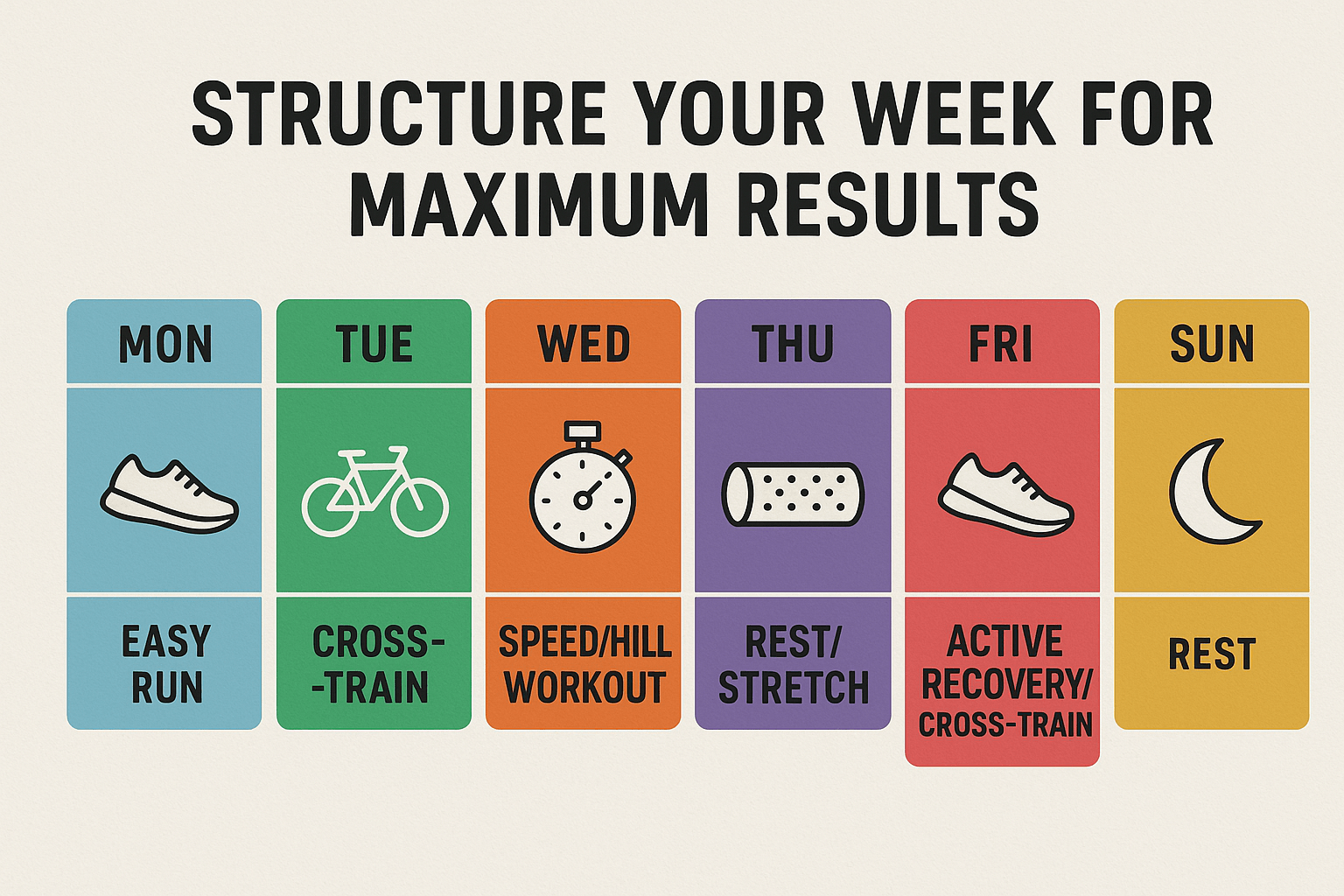As a running coach, I get asked all the time—whether in person or on Twitter—“How often should I run?”
I get it.
You look at your running shoes, think about lacing up, and then wonder if today’s the day to hit the pavement… or take a well-earned break.
Here’s the thing: there’s no simple answer to that question.
What works for one runner might not work for another.
It really depends on where you’re starting, where you want to go, how your body’s feeling – I can go on and on but I bet you get the gest of it.
Yet, don’t worry, by the end of this article, you’ll have a clear idea of how often to run and how to make it work for you.
The Main Factors to Consider
Before we dive into how often you should run, let’s look at what factors play into it.
Here’s what you need to consider:
- Past experience: Are you a seasoned runner or a beginner?
- Current fitness level: How’s your body handling training so far?
- Future goals: What do you want to achieve? Are you aiming for a marathon, or just trying to get healthier?
Once you know where you’re at, you can start figuring out a plan that works for you.
Step 1: Define Your Running Goals
I get it – we all have different reasons for running.
Some of us run to lose weight, others to crush a specific race goal, and some of us just want to feel better in our day-to-day lives.
Here’s how different goals affect your running schedule:
- Weight Loss: If dropping a few pounds is the goal, 2-3 runs a week are great to start. Throw in some run/walk intervals, and you’ve got yourself a solid plan to burn calories and build stamina.
- Seasoned Runner: If you’re already logging some decent miles and you’re aiming for performance goals (speed, distance, race times), 5-6 days of running a week might be more your speed.
Step 2: Understand Your Uniqueness
Let’s be real—there’s no one-size-fits-all answer to how often you should run. Your body, goals, and schedule all play a role in creating a plan that works for you.
In other words: the best training plans are made for you, not for anyone else.
Step 3: Break It Down with Your Goals in Mind
Got your goals locked in?
Awesome. Now, let’s map out the details.
For example:
- Trying to crush your 5k PR? It’s about quality, not quantity. 3-4 runs a week with speed workouts can get you there.
- Long-term health? Start with 2-3 runs a week, throw in some walking or cross-training, and build your foundation.
- Marathon training? We’re talking 4-6 runs per week, plus cross-training for recovery.
Step 4: Assess Your Time Availability
Life’s busy.
We’ve got work, family, social stuff, and everything in between.
So, it’s crucial to be realistic about how much time you can actually dedicate to running each week.
Here’s the deal: staying consistent is what really matters.
If you can’t run every day, that’s cool. But if you can regularly commit to 3-4 runs a week, you’re good to go.
Now let me break down how often should you be running based on your running experience.
How Often Should You Run as a Beginner?
Alright, you’re just starting out.
Maybe you’ve got the shoes, maybe you’ve got the motivation, but now you’re wondering how often should you run as a beginner?
Step 1: Take It Slow—Start Smart
Two to three runs a week is ideal when you’re just starting out.
Why? Well, starting slow helps avoid injury.
Remember, you didn’t wake up one morning and instantly crush 5 miles, right? Same goes for running.
Step 2: Why 2-3 Runs a Week?
Why not try for 5-6 runs, you ask? Well, too much too soon is the quickest route to burnout and injury.
Focus on building your foundation with 20-30 minute runs and incorporate walking breaks if needed.
Step 3: Build Stamina, Not Speed
For now, the goal isn’t speed—it’s getting comfortable with running.
As your body adapts, you’ll start running longer and faster. But remember, don’t rush it. The tortoise wins the race.
How Often Should You Run as an Intermediate Runner?
Okay, so you’ve been running for a few months and have built some consistency. N
ow you’re ready to step it up. Here’s how to level up your running routine:
Step 1: You’re Officially an Intermediate Runner
Congrats, you’re no longer a newbie. You’ve got the basic runs down, and now it’s time to challenge yourself.
Step 2: Aim for 4-5 Runs a Week
This is your sweet spot. 4-5 runs a week gives you the perfect mix of consistency and recovery.
And don’t worry—pay attention to what your body’s telling you.
If you feel like you need a break, take it. Pushing too hard is just setting yourself up for injury.
Step 3: Gradual Volume Increase
The key to progressing without burning out is simple: increase your time and distance slowly. Add about 10% more volume each week, and watch yourself get stronger without overloading your system.
How to Progress From 2 to 5 Days a Week Without Burning Out
Alright, now let’s get to the meat and potatoes: how to safely bump up your running days without burning out.
You’re going to want to start slow and increase by no more than 10-15% per week. No rushing.
If you’re in the beginner phase, increase your frequency gradually—don’t go from 2 days to 5 in one week.
It’s a recipe for disaster.
And, don’t forget to pay attention to what your body’s telling you.
I know, I know.
It’s tough. But trust me, there’s nothing more frustrating than being sidelined for weeks because you pushed too hard.
How to Structure Your Weekly Runs for Maximum Benefit
Now that we’ve got the basics down, let’s talk strategy.
You need to structure your weekly runs to get the most bang for your buck. Here’s the game plan for a well-balanced running week:
- Day 1: Easy-paced run to build your base
- Day 2: Cross-training (get in the pool, hit the bike, or do some strength work)
- Day 3: Speed or hill work to challenge your legs and lungs
- Day 4: Rest, foam roll, and stretch!
- Day 5: Long run at a comfortable pace
- Day 6: Active recovery or cross-train
- Day 7: Rest again.
Consistency doesn’t mean you have to go hard every day. You need to build yourself up over time.
Conclusion: It’s All About Consistency
How often should you run? That’s up to you.
Start with the basics, build your foundation, listen to your body, and focus on consistency over time.
Thank you for stopping by.
Keep training strong.


